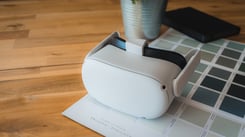If you’re looking to start including VR in your business, there are several things that you need to consider. You need to consider the software your using, what kind of device you want to use, how to bring it into your sales process, and how to make VR an exciting part of your natural presentation flow.
One important thing to consider is the experience of using the device and how certain headsets can play a big part in a person’s VR viewing experience. You want to make sure that a person is comfortable and will be less susceptible to nausea, claustrophobia, or some other possible side effects of using VR.
At Yulio we believe that having a mobile, easy-to-use VR experience as opposed to a non-mobile/tethered VR experience is the best solution to easing someone into VR and providing a natural, comfortable presentation. While VR for business is becoming more common, many of your prospects may not have experienced it before. Be sensitive to the reality that in a business setting, they may feel uncertain about being essentially blindfolded in front of colleagues, or fear looking foolish. In our early user testing, messing up one's hair was a real concern - so consider demonstrating before you put a client inside or other ways of creating comfort
Tethered VR and its Place Today
When we refer to a “tethered VR experience” we are referring to headsets such as the Oculus Rift, HTC Vive, and Valve Index. These are VR Headsets that are powered by an external computer and have a cable running between the headset and the PC. These were the first kind of headsets that became easy to access and affordable to consumers and originally were the only type that allowed for movement in 6 DOF or 6 degrees of freedom - essentially walking or physical movement within a space, vs head movement only.
These types of headsets are the high-end headsets of the VR world. These headsets usually have the best screens, wider viewing angles, higher accuracy in tracking controllers and head movements, and a wider range of fine-tuning when it comes to adjusting the hardware. They often come with a variety of peripherals such as external tracking cameras, controllers for each hand to track your movements in VR, and of course the extra-long cables for plugging into the computer that will provide the processing power the headset needs for the VR experience.
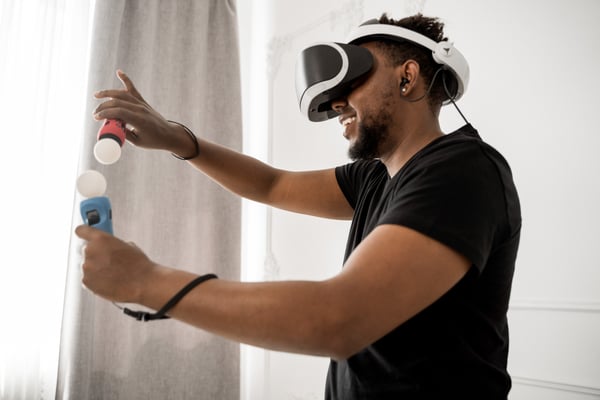
Tethered Headsets have made their initial impact in gaming and are still the main player in that industry today.
Now the reason why these headsets are so high-end, is that tethered VR headsets for consumers are developed in the gaming industry. As we’ve mentioned, these headsets require an external computer to power them, and most often these are gaming PCs developed with specific features for external VR use. These PCs are serious investments for consumers, some even costing multiple thousands of dollars. These tethered headsets are developed to meet those consumer expectations and allow for the best VR experience from these high-end computers.
Constricted by Cables
Tethered VR may be able to offer the peak VR experience to a consumer who is willing to make the commitment that it requires for optimal use. However, when it comes to using in a business situation, those commitments can be a large barrier for a lot of people.
First off there is the cost. You will need an expensive headset and a fairly pricey PC to run a tethered VR experience. Right away that is close to a $1500-2000 investment or even more. As well there will be a time commitment to learn the necessary hardware and software components of these devices. Multiple people may have to be trained and that can be a serious time commitment.
Secondly there comes the physical space needed for the device and its accessories. For most tethered headsets, you will need to mount several cameras or sensors to track the headset. It can be a bit of a hassle to find a spot to set up your optimal VR experience area and changing that location can be a hassle. As well if you are looking to present at a client's place of work, it will be a large hindrance to pack up the entire setup and move to a new place with it, Hoping that your client has appropriate space for it as well.
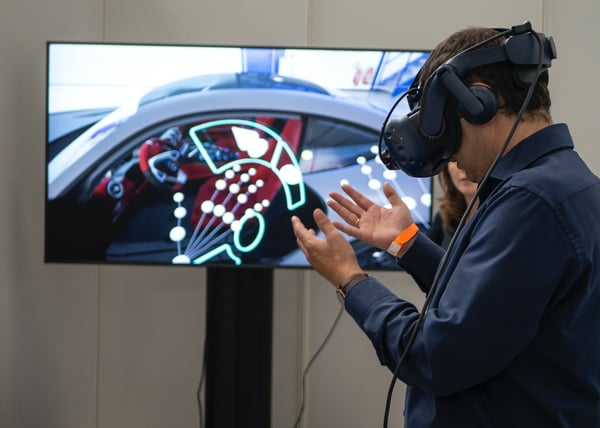
Cumbersome cables can interfere when presenting in VR.
Thirdly comes the physical restrictions of tethered VR. Movement is limited by the cable and sensors, and it doesn’t allow for a lot of flexibility in where and how you can present in VR. Not to mention the “tether” itself. Having a cable attached to the headset is a bit of an obstacle when you have people turning around and trying to view your VR presentation from all angles and it’s easy to get tangled up in it. It can throw off a presentation and ruin the natural experience you are looking to deliver. There are solutions to this such as a hanging wire, but again that’s just more of a physical space commitment.
Breaking Free of the Tether
If all of that is sounding like quite the barrier to setting up VR in your own business, you would be right. And it’s why the VR industry, especially outside gaming has moved to make mobile headsets functional and affordable, with minimal quality loss. At Yulio we recommend looking into mobile VR solutions that offer greater flexibility, lower barriers, and greater ease of access.
A mobile VR experience is a headset or accessory that allows you to view VR without the need to connect to an external device like a PC. We like to think that there are two levels of a mobile VR experience. The first would be an easy-access, quick-view version that can be accessed with a phone and a viewing accessory such as a Homido mini (more on that in a bit). The second would be a higher-end version of mobile VR in the form of a standalone device like the Oculus Quest. These mobile VR solutions may not have the computing power that a tethered headset would have, but either can still offer a satisfactory VR experience that will allow you to share presentations that can still make an impact.
For the easy-access version of mobile VR, as we mentioned this would primarily be driven by the processing power of your smartphone. There are many VR apps available and designed specifically for viewing on a mobile device. However, to create the stereoscope image and view, the phone will display two images side by side on your phone. To get the full effect of VR you will need an accessory of some kind to view VR on your phone.
We recommend the Homido Mini as it is a cost-effective accessory that is easy to use and share. It simply clips onto your phone and gives you a pair of lenses to view the VR images. This allows you to get a satisfactory VR viewing experience. There are other options for accessories such as headsets where you can slide in a phone, but we have used the Homido mini at Yulio for quite some time and it’s a great tool and something easy to carry in our pocket or even hand out at trade shows.
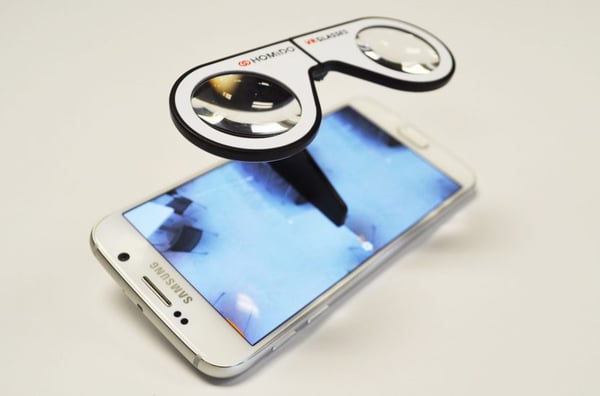
Easy to use and extremely portable, we've been a fan of the Homido Mini for a while.
For a higher-end version of mobile VR, there is the Oculus Quest. This is a VR headset that has very similar specs to a tethered headset in terms of the screens and sensors but does not require an external computer to power it. All the processing hardware is built into the headset itself. It obviously won’t be as graphically intense as its tethered counterparts, but the freedom and mobility it offers are hard to match.
The Oculus Quest offers a more immersive experience than a mobile VR experience powered by a smartphone. That comes from having an enclosed headset that blocks out more of the outside world. As well, the screens which display the VR images inside the headset have a higher resolution and refresh rate than most phones making the VR viewing experience clearer and can reduce eye strain and nausea that can come with viewing on a lesser display. It also has dedicated controllers that make interacting with a VR experience that much easier.
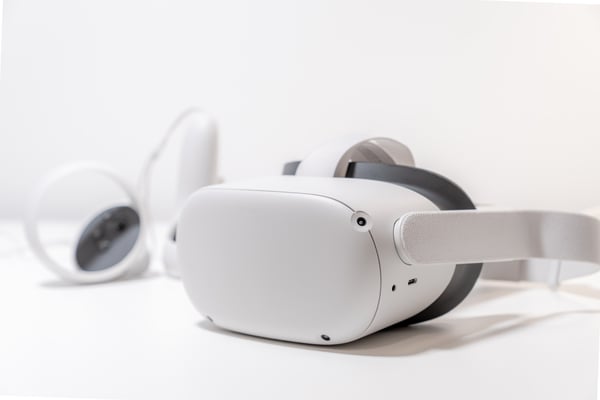
The Oculus Quest has only gotten more and more popular over recent years.
With either mobile VR experience, it is far less costly than tethered ones. For both easy-access and high-end mobile VR, there is no need for an expensive external computer, eliminating that expense. You will still require something to drive the VR experience, whether that is a smartphone or a standalone headset like the Oculus Quest. However, even a standalone headset like the Quest is still just a fraction of the cost of a tethered headset and PC. The Quest headset by itself is still cheaper than some of the tethered headsets on their own.
There will still be a need/consideration for physical space when setting up a mobile VR experience. However, mobile VR experiences eliminate the need for external sensors or cameras to track the headset as those sensors are built into the phone or tech driving those headsets. Phones have built-in gyroscopes which can track the directions your head is moving in. In an Oculus quest, they have gyroscopes as well and built-in outward-facing cameras that replace those external sensors from tethered sets. It’s these which track your surroundings and can be used to set up a safe zone for a VR experience. For either mobile experience, it opens up a lot of flexibility for where you can present and how clients or viewers can engage and interact with the VR experience.
Finally, by removing the clunky cables and eliminating the fear of getting tangled or moving too far away from the PC, a mobile VR experience feels much more natural and feels more accessible to new or inexperienced VR users. We even recommend taking things a step further and removing any straps that hold a VR headset to someone’s head. This allows them to just simply lift the headset to their eyes and then can still look around the virtual world. This can just streamline the process a little more and may make those who are claustrophobic a little more comfortable.
While a mobile VR experience may not be the high-end high-tech experience that one may get through the latest and greatest tethered headsets, the openness and flexibility of a mobile experience are a major benefit. Not to mention the lowers barriers of cost and physical space commitments. It's for these reasons we recommend setting up a mobile VR experience at your business.
For more of our VR presentation tips, sign up today for our Business Ready VR course - it’s a free 5-day program of videos and other assets to make you an expert in 10 minutes a day. Or, if you’re ready to start presenting your designs in VR, grab a free account.





